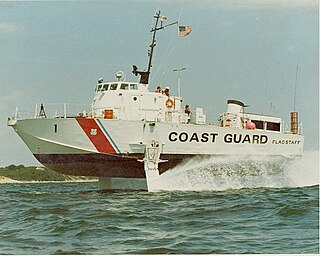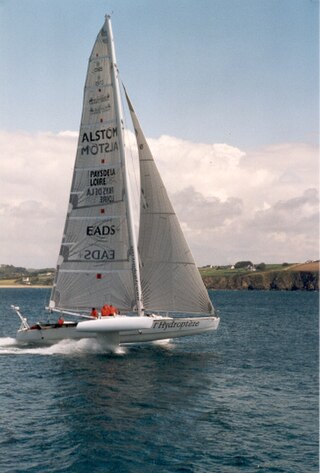A hydrofoil is a lifting surface, or foil, that operates in water. They are similar in appearance and purpose to aerofoils used by aeroplanes. Boats that use hydrofoil technology are also simply termed hydrofoils. As a hydrofoil craft gains speed, the hydrofoils lift the boat's hull out of the water, decreasing drag and allowing greater speeds.

The Massachusetts Institute of Technology (MIT) is a private land-grant research university in Cambridge, Massachusetts. Established in 1861, MIT has played a significant role in the development of many areas of modern technology and science.

Human-powered transport is the transport of person(s) and/or goods (freight) using human muscle power. Unlike animal-powered transport, human-powered transport has existed since time immemorial in the form of walking, running and swimming, as well as small vehicles such as litters, rickshaws, wheelchairs and wheelbarrows. Modern technology has allowed mechanical advantage devices and machines to enhance human-power.

The Pegasus-class hydrofoils were a series of fast attack patrol boats employed by the United States Navy. They were in service from 1977 until 1993. These hydrofoils carried the designation "PHM" for "Patrol Hydrofoil, Missile." The Pegasus-class vessels were originally intended for NATO operations in the North Sea and Baltic Sea. Subsequently, participation by other NATO navies, including Germany and Italy, ceased and the U.S. Navy proceeded to procure six PHMs, which were highly successful in conducting coastal operations, such as narcotics interdiction and coastal patrol, in the Caribbean basin.
A foilboard, also known as a hydrofoil board or foil surfboard, is a type of board used in water sports; it is distinct from surfboards in that it has a hydrofoil rather than fins mounted underneath. This hydrofoil design allows the surfboard and its rider to rise above the water’s surface, allowing for fast speeds and increased maneuverability in a wide range of surf conditions. Foilboards are becoming increasingly popular across many water sports, including surfing, kiteboarding, and wakeboarding. Foilboards have also been used in competitions, with riders reaching speeds of up to 30 km/h while performing acrobatic maneuvers such as flips, twists, and more.

David Gordon Wilson was a British-born engineer who served as a professor of engineering at the Massachusetts Institute of Technology (MIT) in the United States.

HMCS Bras d'Or was a hydrofoil that served in the Canadian Forces from 1968 to 1971. During sea trials in 1969, the vessel exceeded 63 knots, making her the fastest unarmed warship in the world at the time.
The Flyak is a hydrofoil adaptation to the conventional kayak. It uses twin hydrofoils designed to raise the hull out of the water to increase the speed. Speeds of up to 27.2 km/h can be achieved on calm water.

A sailing hydrofoil, hydrofoil sailboat, or hydrosail is a sailboat with wing-like foils mounted under the hull. As the craft increases its speed the hydrofoils lift the hull up and out of the water, greatly reducing wetted area, resulting in decreased drag and increased speed. A sailing hydrofoil can achieve speeds exceeding double and in some cases triple the wind speed.
The Monarch B was a human-powered aircraft, designed and built by graduates and undergraduates of the Massachusetts Institute of Technology, and won the £20,000 first prize for the Kremer World Speed Competition. It is a successor to the Monarch A HPA which preceded it.

USS Flagstaff (PGH-1) was the only Flagstaff-class patrol gunboat (hydrofoil) and was acquired by the United States Navy because of her relatively low cost and very high speed. She was later loaned by the Navy to the U.S. Coast Guard, as USCGC Flagstaff (WPBH-1). The Coast Guard’s interest in the craft was the craft’s speed and its ability to interdict smugglers and other suspicious craft approaching the U.S. coast.

Hydroptère is a French experimental sailing hydrofoil trimaran imagined by the yachtman Éric Tabarly. The Hydroptère project was managed by Alain Thébault, the design done by naval architects VPLP design and the manufacturing by a group of French high-tech companies. Its multihull hydrofoil design allows the sail-powered vessel to reach high speeds on water. The design is based on experience from a range of hydrofoil sailcraft that Thébault built in cooperation with Éric Tabarly since the 1980s. On 5 October 2008 she reached a record speed of 52.86 knots, however this was over a shorter distance than the 500m necessary to qualify for an official world record. On 21 December 2008, the Hydroptère briefly reached 56.3 knots near Fos-sur-Mer, but capsized and turtled shortly thereafter.
Boston Dynamics, Inc., is an American engineering and robotics design company founded in 1992 as a spin-off from the Massachusetts Institute of Technology. Headquartered in Waltham, Massachusetts, Boston Dynamics has been owned by the Hyundai Motor Group since December 2020, but having only completed the acquisition in June 2021.

The paravane is a towed winged (hydrofoiled) underwater object—a water kite. Paravanes have been used in sport or commercial fishing, marine exploration and industry, sports and military applications. The wings of paravanes are sometimes in a fixed position, else positioned remotely or by actions of a human pilot. Pioneer parafoil developer Domina Jalbert considered water kites hardly different from air kites. However, paravanes generally orient themselves in respect to the water surface. They may have sensors that record or transmit data or be used entirely for generating a holding force like a sea anchor does. While a sea-anchor allows a vessel to drift more slowly downwind, the paravane travels sideways at several times the downwind speed. Paravanes are, like air kites, often symmetrical in one axis and travel in two directions, the change being effected by gybing, shunting, or flipping over.

A human-powered hydrofoil is a small hydrofoil watercraft propelled entirely by the muscle power of its operator(s). Hydrofoils are the fastest water-based vehicles propelled solely by human power. They can reach speeds of up to 34 km/h, easily exceeding the world records set by competitive rowing which stand at about 20 km/h. This speed advantage is achieved since hydrofoils lack a submerged body to provide buoyancy, greatly reducing the drag force.

The Sparviero class, also known as the Nibbio class, are small hydrofoil missile boats capable of traveling at speeds of 46 knots. They were designed for and formerly used by the Italian Navy. The Japanese 1-go-class missile boat is an updated version formerly used by the Japan Maritime Self-Defense Force (JMSDF).

High-performance sailing is achieved with low forward surface resistance—encountered by catamarans, sailing hydrofoils, iceboats or land sailing craft—as the sailing craft obtains motive power with its sails or aerofoils at speeds that are often faster than the wind on both upwind and downwind points of sail. Faster-than-the-wind sailing means that the apparent wind angle experienced on the moving craft is always ahead of the sail. This has generated a new concept of sailing, called "apparent wind sailing", which entails a new skill set for its practitioners, including tacking on downwind points of sail.

A hydrocycle is a bicycle-like watercraft. The concept was known in the 1870s as a water velocipede and the name was in use by the late 1890s.
The Wyss Institute for Biologically Inspired Engineering is a cross-disciplinary research institute at Harvard University focused on bridging the gap between academia and industry by drawing inspiration from nature's design principles to solve challenges in health care and the environment. It is focused on the field of biologically inspired engineering to be distinct from bioengineering and biomedical engineering. The institute also has a focus on applications, intellectual property generation, and commercialization.













